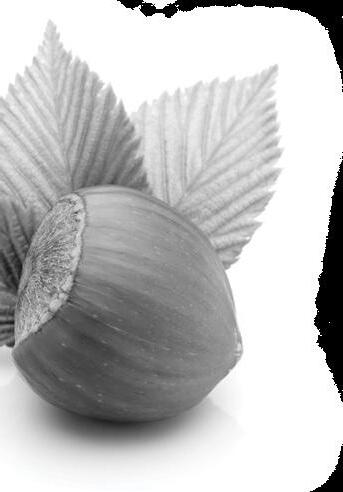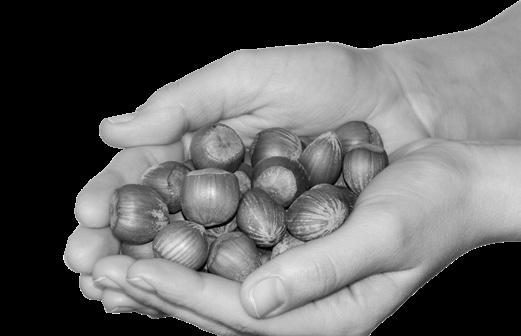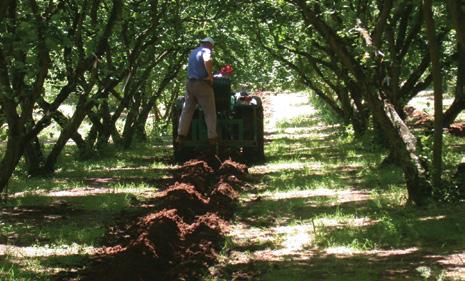
11 minute read
MAIN ISSUES IN PLANNING OF HARVEST
Planting layout and varietal mix 1.1.
Selection of a cultivar is a crucial decision. The choice of a cultivar must be made on the basis of the final destination of the product and its agronomical characteristics (productivity, resistance, or tolerance to main pests). Most of the hazelnuts are intended for industrial processing; therefore, the cultivars that have qualitative (good flavour) and technological characteristics (medium size and round shape, high kernel yield, high peelability) suitable for these purposes are more valued (for example, Tonda Gentile delle Langhe, Tonda di Giffoni, Tonda Gentile Romana, Table 1.1).
Advertisement

Another important parameter that has to be taken into consideration during selection of the varietal mix is adaptability to climate of a cultivar. The knowledge of phenology of each cultivar (in particular, flowering time of male and female flowers, time of leaf budburst, and time of nut maturity) is essential for the selection of a site for planting the cultivar, for its effective pollination, and selection of the appropriate varietal mix.
Tonda di Giffoni
Tonda Gentile delle Langhe syn. Tonda Gentile Trilobata
• Originates from southern Italy (Campania)
• Medium-sized nut (2.5-2.8 g) with round shape (IR = 0.90)
• Vigorous tree
• Semi-ver tical growth
• Nut ripening from the middle till the end of the season (September in Italy)
• High productivity
• Easily peelable: 80-90 %
• High kernel yield: 44-47 %
• High adaptability to different environments
• Originates from nor th-western Italy (Piedmont)
• Small to medium-sized nut (2.2-2.4 g) with triangular-round shape (IR = 0.90)
• Vigorous tree
• Semi-ver tical growth
• Early nut maturity (August in Italy)
• Medium-low productivity
• Easily peelable: 80-90 %
• High kernel yield: 44-48 %
• Originates from central Italy (Lazio)
• Medium-sized nut (2.5-2.7 g) with round shape (IR = 0.95)
• Medium-low vigour tree
Tonda Gentile Romana
• Semi-ver tical growth
• Nut ripening from the middle till the end of the season (September in Italy)
• Medium-high productivity
• Fairly peelable: 50-60%
• High kernel yield: 44-48 %
• Originates from Spain. Grown in western Europe and USA (Oregon)
• Large nut (3.8 g) with round shape (IR = 0.91)
• High vigour tree
Barcelona syn. Fertile de Coutard
• Semi-ver tical growth
• Nut ripening from the middle till the end of the season (September in Italy)
• Medium-high productivity
• Fairly peelable: 50%
• Easily becomes rancid
• Medium kernel ratio: 39-42 %
• Originates from central and southern Italy
• Medium to large nut (3.0-3.2 g) with round shape (IR = 0.92)
• Medium-high vigour tree
• Open branching
Nocchione
• Mid-season nut maturity (September in Italy)
• Easily peelable: 80%
• High productivity
• Low kernel ratio: 38-40 %
The time of nut maturity of the main cultivars given in the Fig. 1.2 refers to average time obtained from Italy. There are no reliable data for Serbia since the orchards are not in a full production phase yet. Fruit ripening can be strongly influenced by weather conditions and many other factors (like the plot’s position, presence of irrigation systems, etc.); therefore, the data referring to the beginning of nut drop, and the duration of the ripening period are indicative only.
Hazelnuts are wind pollinated and self-incompatible; therefore, they need cross-pollination. One tree cannot pollinate itself, nor the trees of the same variety. Different varieties may be compatible or incompatible for pollination among themselves, which is based on a complex system of incompatibility.
The aspects to consider when choosing a pollinizer are:
• genetic compatibility between cultivars (Table 1.2)
• simultaneous flowering of male pollinizer flowers and flowering of female flowers of the main cultivar.
Flowering period of female flowers lasts for a long time (more than four weeks), especially in unfavourable climatic conditions. It is advisable to plant two or even three different pollinizers to ensure that compatible pollen is present throughout the entire flowering period of female flowers of the main cultivar. For this reason, the rule is to choose cultivars with subsequent flowering time of male flowers (for example, flowering of male flowers of Tonda Gentile delle Langhe occurs early while in Tonda Gentile Romana flowering of male flowers occurs late).
The position of pollinizers within a plot may affect the nut harvest activities. The right way to locate different cultivars in an orchard is to plant only one variety per row. The reason for using this method of planting is to easily monitor tree development of different varieties and to facilitate selective spraying if needed.

In small plots, one row of pollinizers may be planted for each 4-5 rows of the main cultivar or two rows of pollinizers for every 8-9 rows of the main cultivar. In large plots, trees can be planted in blocks of the same variety using two or, better, three compatible varieties (Fig. 1.3).
The arrangement in rows makes harvesting easier due to different ripening periods and the need to separate nuts of different varieties when it is not possible to market the fruits of two cultivars together. It should be kept in mind that cultivars with late ripening period (for example, Tonda di Giffoni) may show a delay in ripening time of the fruits (even over a month) and harvest may be conditioned by the climatic conditions during autumn months (September-October), which are generally more humid than the summer ones.
A tree to be planted in a plot may be self-rooted or grafted on non-suckering rootstocks. The emission of suckers is a characteristic of most cultivated hazelnuts which requires frequent interventions to eliminate basal shoots that continuously develop from adventitious buds around the root collar. Suckers must be eliminated because they take away water and nutrients from the plant and they are an obstacle to cultivation operations, especially those necessary for maintaining the soil clean and for harvesting the fruits.
The use of low suckering/non-suckering rootstocks, selected from Corylus colurna (also called the Turkish hazel) and its hybrids, may permanently reduce the need for de-suckering (Fig. 1.4). During harvest, the absence of suckers contributes to reduction in loss of products and saves time during soil preparation (collection by means of sweepers and suction, etc.). No less important is the fact that the elimination of suckering increases the environmental sustainability of hazelnut cultivation, because there is no need for chemical interventions for control of suckers (generally 3-4 interventions per year). Seedlings obtained from free pollination of C. colurna have been used as non-suckering rootstocks, but their grafting compatibility and influence on productivity, when used in combination with some main cultivars, are still under research. In addition, the lack of clonal rootstocks limits wider use of grafted plants.

Effect of tree shape on the selection of mechanization for harvest
The tree shaping system used for hazelnut may be divided into a multi-stem form (bush) and a tree form (bush vase and tree shape) depending on the number of main stems in a plant.
BUSH FORM
Bush is a traditional shape used in many European areas and consists of a plant with a variable number of stems, which is the natural habitus of hazel in nature. Bush form is mainly used in hilly areas characterized by non-irrigated land, sloping position, higher altitude, and in areas subject to wind and abundant snowfalls. In such areas, bush form is preferred because trees can remain productive even if some of the main stems break.
The suggested number of stems is not greater than 4-5 in modern plots (Fig. 1.5); this helps in containing the development of the plant and facilitates the operations of pruning, de-suckering, and harvesting. It is estimated that an average of 25-30 kg per ha is lost when the fruits fall between the main stems which are difficult to reach, especially when de-suckering operations are not done properly. To perform an effective harvest in orchards with bush form plants, pre-harvest activities (such as blowing and sweeping) are essential.
ADVANTAGES
• Easy recovery of plants if damaged by adverse climate conditions
• Growth training pruning for bush is easier than for tree forms
DISADVANTAGES
• Harvesting is more difficult, requires accurate pre-harvest operations
• De-suckering is more complicated and requires more time
1.2. 1.3.
TREE FORMS (bush vase and tree shape)
Tree forms are so called because they have a single main stem (Fig. 1.6). They can be used both for grafted and self-rooted plants, as long as they are properly pruned from the first year of planting. Tree forms allow farmers to reduce the distance between the plants and to completely mechanize working operations on the plantation. Consequently, tree forms are more suitable for flat or slightly sloping land, in fertile soils or where irrigation is possible.

ADVANTAGES
• Harvesting and other activities are easier (de-suckering, weeding, etc.)
• Allow reduction in planting distance
DISADVANTAGES
• Suitable only for vigorous varieties
• Training pruning is more difficult than for bush
• If a plant is seriously damaged, it has to be replaced
• Less productive in the first years
Pedo-climatic conditions (soil type, terrain configuration, altitude, climatic condition)
Soil
The type of soil and the terrain configuration of a hazelnut grove may have a great influence on harvest. Heavy soils can create harvesting problems due to difficult entry of the machines in case of precipitation, and for this reason it is essential that a hazelnut grove is kept grassed, at least in the space between the rows, to allow greater lift and less soil compaction. Grassing should be also used on sloping land where soil erosion occurs due to the runoff of water following intense rainfall, which can lead to the accumulation of hazelnuts in piles and cracks in the soil. High humidity of the soil leads to rapid deterioration in the quality of the product if it is not dried promptly.
In general, to facilitate harvesting operations, the suggested management of the soil involves the combination of soil processing techniques in the row and controlled grassing in the inter-row, similar to what is done for other fruit species. This type of soil management has to be considered the rule in the first 2-3 years after planting, when competition for water and nutrients between young seedlings and herbaceous cover species must be limited as much as possible. During the following years, it is possible to keep the entire hazelnut grove covered with grass to make the most of the function of the grass cover, using a mulcher with disk to mow grass in the row (Fig. 1.7).
Climate Conditions
The selection of the varietal mix includes an accurate evaluation of climate conditions at the site of planting. In places where the climate is particularly wet in late summer – early autumn, early ripening cultivars (August) are more suitable than the late ones which ripen in late September-early October. Rains during harvesting period delay ripening, since plants vegetate longer and nuts hardly drop to the soil due to the husks that remain green. In addition, the impossibility to enter the orchard causes a delay in mechanical harvesting operations which lead to a deterioration of the quality of the fruit. With the increment of altitude, the ripening period of the fruit can be delayed by 2-3 weeks, especially in cultivars with late maturity. However, some of the main varieties were selected in traditionally hilly areas, characterized by a good ventilation, cool temperatures in summer (hardly above 30 °C) but not particularly cold winters. In such conditions, these cultivars performed well, offering good productivity and products of excellent quality.
Before choosing a cultivar, it is advisable to accurately evaluate climate conditions at the area of cultivation. You can ask for meteorological data from a weather station near your area, especially temperature and precipitation data. During harvest period, you should pay attention to weather forecasts as they help in planning pre-harvest and harvest operations.
Dynamic of yield increasement per year
Grassing can be performed using the spontaneous flora present in the hazelnut grove or by sowing mixtures of different species (Fig. 1.8). The best solution is to use a combination of low vigour grass species (for example, Festuca ovina and Festuca rubra) and self-seeding legumes (such as Trifolium subterraneum). These are particularly suitable because they use a little water for their own development and have a good resistance to shading. Adult hazelnut plants have dense canopies that let little light filter into the ground. For this reason, spontaneously or artificially grown grass can be difficult to keep in good condition once the hazelnut plants enter full production.
The advantages of grassing from the aspect of harvesting operations are:

• increasing of bearing capacity of the soil
• lower compaction generated by passing of agricultural machinery
• less production of ‘dust’ during harvesting operations, which is considered one of the main risk factors for the health of farmers (see chapter 3.6)
• keeping the nuts cleaner and more difficult to move in case of heavy rain (especially in sloping terrain).
The precocity of production is strongly influenced by the quality of the plants used for the planting. The best materials are those plants obtained by layering, cutting or micropropagation, which have grown in a nursery for at least one year. They have to display a good root system and a diameter of the stem of 1-2 cm. The plants that come from accredited nurseries, with a certification for genetic identity and absence of pests, ensure greater success in establishing a new orchard in comparison with material with unknown origin. If a hazelnut plant is made with an adequate starting material, the first production is obtained in the third or fourth year of planting and productivity increases till the 8-10th year. The duration of a modern hazelnut grove is estimated at about 30 years; bush plants can have a longer life thanks to the possibility of periodical renewal of the main stems.
The orchard management in first years after planting is crucial for obtaining vigorous and healthy plants. In particular, the competition for water and nutrients has to be minimized keeping the soil clean from weeds. At the same time, the existence of irrigation and the correct fertilization helps to reduce the initial unproductive period and decreases the alternation of production (tendency to alternate years of high productivity with years of low productivity) in the period of full production of the hazelnut grove.
The dynamic of yield growth changes considering different cultivars. In a study conducted in Chilean hazelnut groves, cultivars such as Tonda di Giffoni and Barcelona displayed a very high yield growth rate in the first years after planting and reached their average maximum yield values rapidly (Fig. 1.9). Instead, Tonda Gentile delle Langhe (TGL) has a lower growth rate and its average maximum yield value is reached several years after the previously mentioned cultivars.

Plant protection before and during the harvesting period 1.5.
A plan for the control of diseases and pests in hazelnut plantations requires good knowledge of the main pathogens of hazelnuts. In general, a hazelnut grove kept in good cultivation conditions displays fewer phytosanitary problems. The correct choice of planting layouts and training system, together with adequate pruning, greatly increases the effectiveness of phytosanitary treatments since they allow easy passage of the sprayers, ensure adequate light penetration into the canopy and good ventilation. A correct control plan includes the phytosanitary treatments during winter and vegetative season, but also a series of agronomic interventions, such as proper pruning and an effective soil management.
At the time of harvest, all phytosanitary treatments for fungi and insect control have to be previously conducted in the hazelnut grove. When the first hazelnuts begin to fall, they must be carefully examined since the fruits that fall early are often not healthy; among the hazelnuts that fall prematurely there are often empty nuts (blanks, that is without seeds), fruits infested by nut weevil and those stung early by bugs, which generally have shrivelled kernels.
Regarding bugs, the most damaging is Brown Marmorated Stink Bug (BMSB, Halyomorpha halys) that attacks hazelnuts in all development stages, from fruit set to harvest (Fig. 1.10). It has a very high reproduction rate, with two generations per year in Europe. The chemical control of BMSB is very difficult since infestations occur very close to harvest, and sometimes the most severe ones are between the first and the second harvesting steps.

Due to its frequent movement between crops (for example, soybean, corn), BMSB is generally more abundant on the edges of the orchard. Bugs move from crops after harvest to shelter in wild untreated areas or on windbreak or other plants on the border. It is necessary to plan spraying of these areas near the hazelnut grove, if the BMSB population is abundant. This strategy of control works well especially for large plots, where the treatments at the edges of the field greatly limit the entry and spread of bugs within the hazelnut grove itself.





